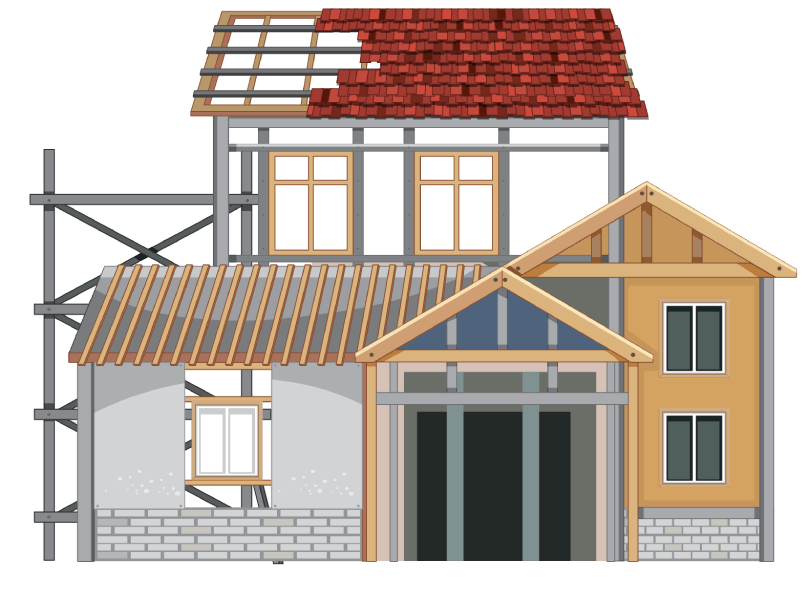Mortgages for Steel Frame Properties
Dive into our guide to mortgages for steel-framed properties, covering what they are, their advantages and disadvantages, associated costs, and how to secure a mortgage on one.

A considerable number of steel-framed homes exist in the UK. These houses, built primarily with a structural steel frame instead of traditional wooden frames or brickwork, started appearing in the 1920s.
However, it wasn’t until the 1940s that they became more widespread, as they provided a swift and affordable solution to post-war housing challenges. By the 1970s, though, concerns over structural integrity led to a decline in newly built houses using this system and lenders now class them as non-standard construction, restricting the availability of mortgages.
Despite their unique frame, from the outside steel-framed properties closely resemble other homes but often have shorter expected lifespans than conventional properties, making them a potential risk for both buyers and lenders.
What is a steel frame house?
A steel-framed property refers to a building where the main structural components are made of steel. These steel frames provide support to the building’s walls, floors, and roof, creating a metal skeleton for the property.
The steel frame is often not obvious, being hidden behind cladding, external brickwork or render.
When compared to a brick house, steel-framed homes are quicker to build, as the steel components are manufactured off-site and assembled on location with relative ease. Moreover, steel is eco-friendly since it’s recyclable and generates less waste during construction.
But, of course, there’s always another side to the story. Steel-framed homes can be more expensive to build, they require specialised contractors and the steel can suffer from corrosion over time.
Consequently, steel-framed properties are more challenging to secure a mortgage for, as lenders view them as non-traditional construction with a higher risk.

Some quick pros and cons
Steel frame Pros:
- Customisation and assembly: Steel components can be pre-made, shaped, and clad in various materials, then quickly assembled on-site using bolting, welding, or riveting.
- Water resistance: Steel handles water damage better than wood, with added treatments enhancing its rust resistance.
- Fungus resistance: Steel is immune to woodworm and termites.
- Lightning protection: Steel frame panels are grounded, efficiently dissipating lightning strikes.
- Durability: Steel is incredibly durable, withstanding Level 9 earthquakes and hurricane-force winds due to its flexibility.
- Non-combustible: Steel’s fire resistance may result in insurance discounts.
Steel frame Cons:
- Non-standard construction: Steel framed houses require a Building Survey rather than a HomeBuyers Report, which costs more.
- Detection difficulty: Corrosion is hard to detect without intrusive inspections, which sellers may not allow.
- Insulation issues: Steel houses have poorer insulation and energy efficiency due to thermal bridging.
- Corrosion risk: Steel components may corrode, especially at wall stanchions bases, galvanised steel windows, and joins to the concrete ground floor slab.
- Special tools and knowledge: Maintenance and construction of steel frame homes require specialised tools and expertise.
Can you get a mortgage on a steel framed house?
Obtaining a mortgage for a steel frame house follows a similar process to a traditional mortgage, with lenders assessing the property’s value through a survey and valuation. As steel-framed homes are categorised as non-standard construction, they necessitate specialist property mortgages, which not all banks or mortgage lenders offer.
Lenders are more cautious when dealing with non-standard construction properties, requiring borrowers to provide extra documentation and adhere to stricter guidelines.
In some cases, lenders may ask for specialist reports, but most will rely on a Home Report in Scotland or a comprehensive survey and valuation in the UK. The surveyor’s comments in their report will significantly influence a lender’s decision on the property’s mortgage suitability.
Lenders may also limit the loan-to-value ratio to manage risk, resulting in borrowers needing a larger deposit than they would for a traditionally built home.
Despite these hurdles, obtaining a mortgage for a steel frame house is achievable with the right guidance from an experienced mortgage broker. Borrowers should be prepared for additional steps in the process, but with perseverance, securing a mortgage for a steel frame property is possible.

ABC
Mortgage lenders categorise steel-frame houses as A, B or C.
Category A means that the house is mortgageable in its original condition. Category B means that a property is mortgageable following approved repairs. The C grade means defective and it is therefore not mortgageable.
Mortgage Criteria
The lending criteria for steel framed properties can vary significantly among lenders.
The building survey report is all important. If the lender perceives the property as a high risk, they may reject the application or offer a lower loan-to-value (LTV) ratio.
For example, some lenders will only offer a 50% LTV, meaning you will need to provide a 50% deposit for the property.
The age of the property is important with some lenders only approving properties built after the 1960s, while others may have even stricter requirements, such as only accepting properties built after 2000.
Basic information, such as proof of identification, current address, and income information for all mortgage applicants, is also necessary.

Deposit Requirements for Steel-Framed Homes
A larger deposit will be necessary for a steel-framed home mortgage due to the increased risk for lenders. Steel-framed properties are more prone to movement, corrosion and other issues, making them harder to sell if repossessed.
A larger deposit demonstrates greater financial security and reduces the likelihood of defaulting on mortgage payments, making you a more appealing candidate for a non-standard construction mortgage. While it’s possible to find standard property mortgages with deposits as low as 5% or 10%, steel-framed property mortgages may require a deposit of at least 20-25%.
Be aware that deposit requirements may also depend on the property’s specifics, with some specialist lenders requiring higher deposits for riskier properties, such as those past their expected lifespan.
Surveys
A comprehensive survey by a qualified surveyor experienced in steel-framed buildings is necessary before applying for a mortgage. This will not only increase your chances of receiving mortgage offers but also help prevent future issues.
Before making an offer on a steel framed property, it’s crucial to have a thorough building survey done. Since this type of property is classified as ‘non-standard’, a Level 3 home survey may be necessary. A qualified surveyor will inspect the property, looking for any potential issues that could affect its value or make it harder to resell in the future.
It’s important to note that not all steel framed houses are built the same way, and some are considered less risky than others. If the survey goes well and the property is deemed low-risk, it can increase the chances of securing a mortgage.
If you’re applying for a mortgage with a lender who offers mortgages for steel framed homes, they’ll usually carry out a thorough inspection of the property themselves. However, this can make the application process longer than usual and may require more administrative work.
A surveyor will examine various aspects of your potential new home, including:
- Structural stability
- Presence of asbestos or other hazardous materials
- Dampness in walls and floors
- Corrosion and rust
- Subsidence – movement of the foundation
- Pests and infestations, such as rats, mice, termites, or woodworms
- Roofing issues, including leaks or damage
- Drainage problems, like leaks, blockages, or corrosion
Keep in mind that steel-framed houses inherently carry a range of risks and structural issues. Even if the survey deems the property satisfactory, be prepared for potential problems during your ownership.
CONTACT A MORTGAGE BROKER
If you are ready to take the next step then we can put you in touch with a fully qualified independent mortgage broker.
What are the various kinds of steel frame houses?
Numerous steel frame types exist, produced by a wide range of manufacturers. Some notable building companies and their respective steel frame types include Trusteel MkII, Trusteel 3M, Telford (1920s), British Steel Houses Ltd (BISF), Nissen-Petren, Falkiner-Nutall, Birmingham Corporation, Arrowhead, Keyhouses Unibuilt, Steane, and British Housing.
British Iron and Steel (BISF) Houses
A BISF house, short for British Iron and Steel Federation house, is a type of prefabricated house constructed in the United Kingdom during the post-World War II era. The BISF house was developed to address the severe housing shortage that occurred after the war, as many homes were damaged or destroyed during the conflict.
Built by British Steel Houses Ltd, it features a steel frame, which provides the main structure, with a combination of steel and concrete for the external walls. The houses were designed for quick and efficient construction, making use of prefabricated components that could be easily assembled on-site.
BISF houses have several distinct characteristics, including:
- A two-storey design with a pitched roof.
- Steel frame construction, which provides the primary structural support.
- Metal cladding on the upper floor, typically covered with a render or painted finish.
- Traditional brick or blockwork on the ground floor.
- Large windows, often arranged in a symmetrical pattern on the front facade.
BISF houses were designed and built as permanent homes with an expected lifespan similar to that of a traditional brick built house.
Many mortgages were provided back in the 1970-80s under the Right to Buy Scheme. This allowed five million council house tenants the right to buy their own homes. By 2003 1.5 million homes were bought this way and many of them were BISF houses.
However, they are currently considered as non-standard construction, which limits the mortgage possibilities.
Homes like these can undergo reinforcement to enhance their stability, but such modifications can be costly. Consequently, BISF houses might be less attractive to buyers seeking an affordable option. However, if the house has already been reinforced before purchase and successfully passes a survey, obtaining a mortgage should be possible.
First Time Buyers
Mortgages lenders do offer first time buyer mortgages for steel framed houses.
Buying your first home is an exciting event and a milestone.
But it’s important not to get too carried away.
It’s natural to want to find an affordable property with the space that you need. With a limited budget the steel framed homes, and concrete houses, can be tempting, as they will be ‘cheaper’ than a comparable brick house.
The low initial price is appealing but it’s important to consider the maintenance and reinforcement costs that may be needed, and how long the structure will last.
These types of property can struggle to sell, mainly due to the mortgage situation and the fact that they won’t last as long as a standard construction house.
Contact an independent mortgage broker to see what your options are.

Final thoughts
It is really important that you research all of your options when buying an older style steel framed property. Not only is the mortgage more difficult to arrange, but you will likely face quite high maintenance costs over the coming years. The property won’t appreciate at the same rate as a brick home and it will take longer to sell when you eventually decide to move.
In terms of the mortgage, you need to speak to a broker as there are a limited number of lenders that accept these properties.
Respect Mortgages can put you in touch with one of the UK’s best known brokers, who have qualified specialists helping clients get the mortgages they need.
Frequently asked questions
Steel framed houses have a shorter lifespan than traditional brick and mortar homes. The exact lifespan of a steel framed house will depend on several factors, such as the quality of the construction, the maintenance history of the property, and the local climate.
In general, steel framed houses have a lifespan of around 30-50 years. However, with proper maintenance and repairs, a steel framed house can last longer.
Selling a steel framed home can be more challenging than selling a standard property due to the perceived risks associated with this type of construction. The structural issues and potential maintenance costs associated with a steel frame can make the property less attractive to buyers. Additionally, the fact that some lenders may not offer mortgages on steel framed homes means that there are fewer potential buyers in the market.
However, it’s not impossible to sell a steel framed home. If the property is well-maintained and free of any major structural issues, and you have a thorough survey report and documentation to back this up, it may still be an attractive purchase for some buyers. It’s important to price the property competitively based on its condition and location.
It’s worth noting that when you’re ready to sell your steel framed home, you’ll need to disclose the type of construction to potential buyers.
In general, mortgages for steel framed homes may be more expensive than mortgages for standard homes.
This is because they are considered non-standard properties and may pose more risk to lenders. As a result, lenders may require a higher deposit and charge a higher interest rate to compensate for the increased risk.
Additionally, getting insurance for a steel framed home may also be more expensive due to the potential risks involved. However, the exact cost of the mortgage will depend on factors such as the lender, the deposit size, and the borrower’s credit history. It’s important to do thorough research and compare offers from different lenders to find the best possible deal.
Yes, it’s possible to get a buy-to-let mortgage on a steel framed property. However, the same challenges apply as with a standard mortgage for this type of property.
You may need to provide a larger deposit and pay a higher interest rate, and some lenders may not consider lending on a steel framed property at all. It’s important to do your research and work with a specialist mortgage broker who can help you find lenders who are willing to offer buy-to-let mortgages on steel framed properties.
Yes, you will need specialist buildings insurance for a steel framed property. This is because these properties are considered non-standard, and may be more prone to certain risks than traditional brick or timber frame homes.
You may need to find an insurance provider who specialises in non-standard construction homes, and the cost of insurance may be higher than for a standard home. It’s important to factor this into your budget when considering buying a steel framed property.
Both timber and steel each have their own advantages and disadvantages. But timber is the preferred material, with around 25% of all homes built using a timber frame.
There are a few ways to determine if a property has a steel frame. One way is to check the property’s construction plans or the original building specifications. Another way is to look for visible steel elements in the structure, such as steel beams, columns or girders.
To be sure, you can hire a surveyor or structural engineer to assess the property and confirm if it has a steel frame.
Steel-framed houses and prefabricated (prefab) houses are not the same, although they share some similarities. Steel-framed houses refer specifically to homes built with a steel frame structure, whereas prefab houses encompass a broader range of construction types and materials, including steel, timber, and concrete.
Prefab houses are built off-site, with their components manufactured in a factory and then transported to the construction site for assembly. This construction method can be applied to various materials, including steel framing. In other words, a steel-framed house can be a prefab house if its components are prefabricated, but not all prefab houses are steel-framed.
Obtaining a mortgage for a steel-framed house can be difficult due to their non-standard construction.
Lenders perceive these properties as higher risk due to durability concerns, the need for specialised surveys, insurability issues, and lower resale potential. However, working with a specialist mortgage broker or lender can help navigate the process.

